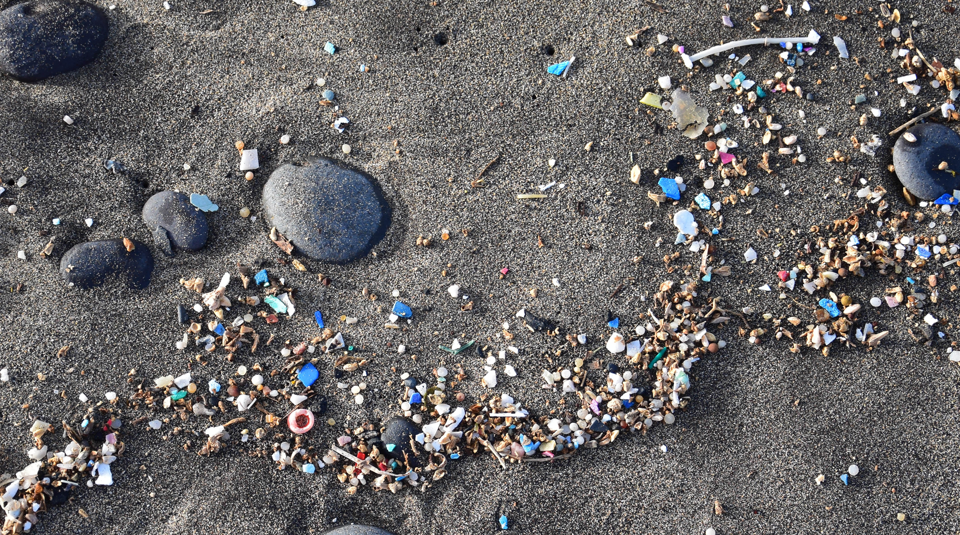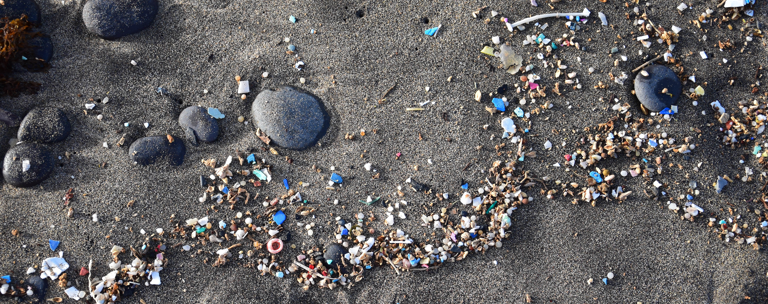AIM² – Aotearoa Impacts and Mitigations of Microplastics, a five-year Ministry of Business, Innovation and Employment (MBIE) Endeavour Funded project, which concluded this year, has unveiled unsettling truths about the pervasive presence and impact of microplastics in Aotearoa New Zealand. The study highlights the widespread distribution of microplastics and their potential detrimental effects on both the environment and human health.
Microplastics are tiny particles of plastic 0.001 to 5 mm in size. They can be what’s known as ‘primary’ plastic particles, which were specifically designed to be small in size, or ‘secondary’ particles fragmented from larger plastic items. It’s estimated there are more than 15 trillion pieces of microplastic debris in the world’s oceans, 80 percent originating from land-based activities.
Led by ESR’s Dr Olga Pantos and Dr Grant Northcott from Northcott Research Consultants Ltd, AIM² brought together experts from six research institutes and universities, to improve the knowledge and understanding of the level and movement of microplastic pollution in freshwater, marine and terrestrial environments in Aotearoa. They also assessed the risk they pose to organisms and ecosystems and the knock-on effects to our nature-based economy and wellbeing.
The project has produced 40 research articles (with six more in progress), and a range of reports. The following are key findings of the research:
Microplastics found in remote areas
Microplastic particles have been discovered not only in heavily populated areas but on beaches and in coastal waters of some of the most remote regions of New Zealand. This widespread distribution underscores the far-reaching impact of plastic pollution.
Persistence of biodegradable plastics
Polylactic acid (PLA), a common biodegradable plastic marketed as environmentally friendly, remains chemically and structurally unchanged after one year in the sea. This was observed in three distinct locations across New Zealand, challenging the notion that because it's compostable it isn’t a threat to the environment.
Chemical contaminants in marine plastics
Marine plastic pollution collected from beaches around New Zealand is associated with a large number of chemical contaminants. These contaminants pose significant risks to marine life and ecosystems.
Transfer of contaminants to marine life
The study found chemical contaminants from beached plastics can be transferred to animals that ingest them. This raises concerns about the health of marine organisms and the potential implications for the food chain, including humans who may consume the food species that ingest them.
Biowaste reuse and soil pollution
Biowaste reuse practices in New Zealand have been identified as a significant source of microplastic pollution to soils. This highlights the need for better waste management practices to mitigate soil contamination. Whilst ensuring the nutrients in these sources of biowaste are returned to the soil, protecting soil health and function.
Exposure to harmful plastic additives
Organisms that ingest plastics experience greater exposure to plastic additives, including known chemicals of concern. Sublethal effects at the organism level can translate to ecosystem level effects.
Dr Pantos says the research underscores a critical message: “Plastic is a source of pollution at every stage of its lifecycle. The current business-as-usual approach is leading to irreversible damage to the health of our environment and poses a significant threat to human health and well-being. Urgent action is needed to address plastic pollution and protect the natural world for future generations.”
Research produced by AIM²
- Baettig, C.G. et al., (2024). Characterization of the transcriptional effects of the plastic additive dibutyl phthalate alone and in combination with microplastic on the green-lipped mussel, Perna canaliculus. Environmental Toxicology and Chemistry. https://doi.org/10.1002/etc.5893
- Li, G. et al., (2024). Transport and Retention of Sinking Microplastics in a Well-Mixed Estuary, Marine Pollution Bulletin, https://doi.org/10.1016/j.marpolbul.2023.115395
-
Maday et al., (in press) Taxonomic variation, plastic degradation, and antibiotic resistance traits of plastisphere communities in the maturation pond of a wastewater treatment plant. Applied and Environmental Microbiology.
-
Ruffell et al., (in press) A method for the extraction of microplastics from solid biowastes including biosolids, compost, and soil for analysis by µ-FTIR. MethodsX.
-
Pantos et al., (in press) Sources of nanoplastic and microplastic pollution which are hidden in plain sight. Cambridge Prisms: Plastics
-
Gambarini et al., (2024) Uncoupled: Investigating the lack of correlation between the transcription of putative plastic-degrading genes in the global ocean microbiome and marine plastic pollution. Environmental Microbiome. https://doi.org/10.1186/s40793-024-00575-4
-
Bridson et al., (2024) Leaching and transformation of chemical additives from weathered plastic deployed in the marine environment. Marine Pollution Bulletin. https://doi.org/10.1016/j.marpolbul.2023.115810
-
Baker et al., (2024) System effects mapping: a tool for promoting collaborative community ecological action. Frontiers in Environmental Science. https://doi.org/10.3389/fenvs.2024.1356065
-
Theobald et al., (2024) An investigation into the stability and degradation of plastics in aquatic environments using a large-scale field-deployment study. Science of the Total Environment. https://doi.org/10.1016/j.scitotenv.2024.170301
-
Masterton et al., (2023) The role of plastics in the accumulation and release of trace elements in the environment. Cambridge Prisms: Plastics. https://doi.org/10.1017/plc.2023.15
-
Laroche et al., (2023) A spatio-temporal analysis of marine diatom communities associated with pristine and aged plastics. Biofouling. https://doi.org/10.1080/08927014.2023.2226069
-
Bridson et al., (2023) Release of additives and non-intentionally added substances from microplastics under environmentally relevant conditions. Environmental Advances. https://dx.doi.org/10.2139/ssrn.4159402
-
Bridson et al., (2023) Solving a microplastic dilemma? Evaluating additive release with a dynamic leaching method for microplastic assessment (DyLeMMA). MethodsX. https://doi.org/10.1016/j.mex.2023.102221
-
Rambacher et al., (2023) Transforming Encounters: A review of the drivers and mechanisms of macrofaunal plastic fragmentation in the environment. Cambridge Prisms: Plastics. https://doi.org/10.1017/plc.2023.6
-
Barrick et al., (2022) Investigating the ecotoxicity of select emerging organic contaminants towards the marine copepod Gladioferens pectinatus. Environmental Toxicology and Chemistry. https://doi.org/10.1002/etc.5275
-
Cai et al., (2022) Enhancing consumption responsibility to address global plastic pollution. Marine Pollution Bulletin. https://doi.org/10.1016/j.marpolbul.2022.114089
-
Ladewig et al., (2023) Real-world impacts of microplastic pollution on seafloor ecosystem function. Science of The Total Environment. https://doi.org/10.1016/j.scitotenv.2022.160114
-
Ataria et al., (2023) Orienting the Sustainable Management of Chemicals and Waste toward Indigenous Knowledge. Environmental Science & Technology. https://doi.org/10.1021/acs.est.3c04600
-
Audrézet et al., (2022) Does plastic type matter? Insights into non-indigenous marine larvae recruitment under controlled conditions. Peer J. https://doi.org/10.7717%2Fpeerj.14549
-
Audrézet et al., (2022) Eco-Plastics in the Sea: Succession of Micro- and Macro-Fouling on a Biodegradable Polymer Augmented With Oyster Shell. Frontiers in Marine Science. http://dx.doi.org/10.3389/fmars.2022.891183
-
Aves et al., (2022) First evidence of microplastics in Antarctic snow. The Cryosphere. https://doi.org/10.5194/tc-16-2127-2022, 2022
-
Chen et al., (2022) Retention and dispersion of buoyant plastic debris in a well-mixed estuary from drifter observations. Marine Pollution Bulletin. https://doi.org/10.1016/j.marpolbul.2022.113793
-
Gambarini et al., (2022) PlasticDB: a database of microorganisms and proteins linked to plastic biodegradation. Database. https://doi.org/10.1093/database/baac008
-
Hunter et al., (2022) Quantification and Characterisation of Pre-Production Pellet Pollution in the Avon-Heathcote Estuary/Ihutai, Aotearoa-New Zealand. Microplastics. https://doi.org/10.3390/microplastics1010005
-
Lear et al., (2022) Microbial abilities to degrade global environmental plastic polymer waste are overstated. Environmental Research Letters. http://dx.doi.org/10.1088/1748-9326/ac59a7
-
Ockenden et al., (2022) Disentangling the influence of microplastics and their chemical additives on a model detritivore system. Environmental Pollution. https://doi.org/10.1016/j.envpol.2022.119558
-
O’Kelly et al., (2022) Fate and impact of nano/microplastic in the geoenvironment — ecotoxicological perspective. Environmental Geotechnics. http://dx.doi.org/10.1680/jenge.22.00053
-
Pantos 2022. Microplastics: Impacts on corals and other reef organisms. Emerging Topics in Life Sciences. https://doi.org/10.1042%2FETLS20210236
-
Wallbank et al., 2022. Into the plastisphere, where only the generalists thrive: Early insights in plastisphere microbial community succession. Frontiers in Marine Science. https://doi.org/10.3389/fmars.2022.841142
-
Barrick et al., 2022. First transcriptome of the copepod Galdeoferans pectinarus subjected to chronic contaminant exposures. Aquatic Toxicology. https://doi.org/10.1016/j.aquatox.2021.106069
-
Audrézet et al., 2021. Biosecurity implications of drifting marine plastic debris: Current knowledge and future research. Marine Pollution Bulletin. https://doi.org/10.1016/j.marpolbul.2020.111835
-
Barrick et al. 2021 Plastic additives: challenges in ecotox hazard assessment. PeerJ. https://doi.org/10.7717%2Fpeerj.11300
-
Bridson et al., 2021 Leaching and extraction of additives from plastic pollution to inform environmental risk: A multidisciplinary review of analytical approaches. Journal of Hazardous Materials. http://dx.doi.org/10.1016/j.jhazmat.2021.125571
-
Gambarini et al., 2021 Phylogenetic Distribution of Plastic-Degrading Microorganisms. mSystems http://dx.doi.org/10.1128/msystems.01112-20
-
Hope et al., 2021. The distribution and ecological effects of microplastics in an estuarine ecosystem. Environmental Pollution http://dx.doi.org/10.1016/j.envpol.2021.117731
-
Knobloch et al. 2021 Comparison of Deposition Sampling Methods to Collect Airborne Microplastics in Christchurch, New Zealand. Water, Air, & Soil Pollution. https://link.springer.com/article/10.1007/s11270-021-05080-9
-
Ladewig et al., 2021. A call to evaluate Plastic’s impacts on marine benthic ecosystem interaction networks. Environmental Pollution. https://doi.org/10.1016/j.envpol.2021.116423
-
Lear et al., (2021) Plastics and the microbiome: impacts and solutions. Environmental Microbiome. https://doi.org/10.1186/s40793-020-00371-w
-
Ockenden et al., 2021. Towards more ecologically relevant investigations of the impacts of microplastic pollution. Science of the Total Environment. https://doi.org/10.1016/j.scitotenv.2021.148507
-
Ruffell et al., 2021. Wastewater treatment plant effluents in New Zealand are a significant source of microplastics to the environment. NZ Journal of Marine and Freshwater Research. https://doi.org/10.1080/00288330.2021.1988647
-
Stockin et al., 2021. Fourier-transform infrared (FTIR) analysis identifies microplastics in stranded common dolphins (Delphinus delphis) from New Zealand waters. Marine Pollution Bulletin. https://doi.org/10.1016/j.marpolbul.2021.113084
-
Zhengyu et al., 2021. Effects of pristine micro- and nanoplastics on soil invertebrates: a systematic review and meta-analysis of available data. Science of the Total Environment http://dx.doi.org/10.1016/j.scitotenv.2021.147784
-
Webb et al., (2019) Microplastics in the New Zealand green lipped mussel Perna canaliculus. Marine Pollution Bulletin. https://doi.org/10.1016/j.marpolbul.2019.110641
-
Dikareva and Simon (2019). Microplastic pollution in streams spanning an urbanisation gradient. Environmental Pollution. http://dx.doi.org/10.1016/j.envpol.2019.03.105


